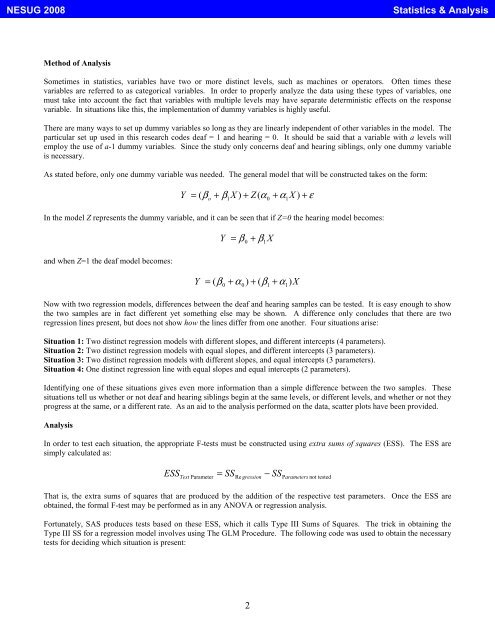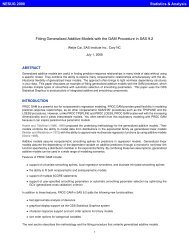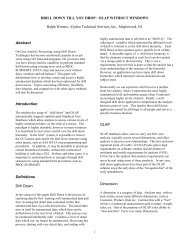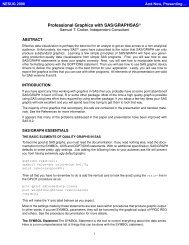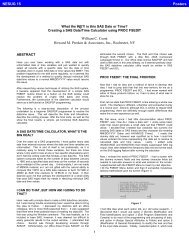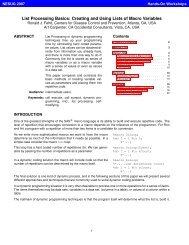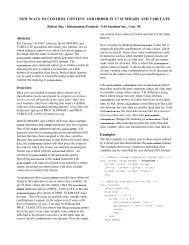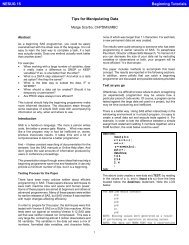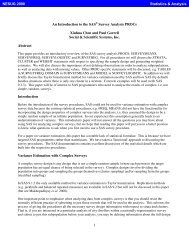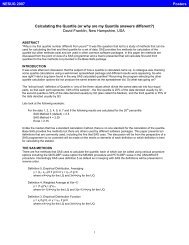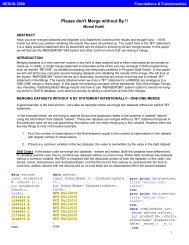Dummy Variables and the Relationship of Deaf and ... - NESUG
Dummy Variables and the Relationship of Deaf and ... - NESUG
Dummy Variables and the Relationship of Deaf and ... - NESUG
- No tags were found...
You also want an ePaper? Increase the reach of your titles
YUMPU automatically turns print PDFs into web optimized ePapers that Google loves.
<strong>NESUG</strong> 2008Statistics & AnalysisMethod <strong>of</strong> AnalysisSometimes in statistics, variables have two or more distinct levels, such as machines or operators. Often times <strong>the</strong>sevariables are referred to as categorical variables. In order to properly analyze <strong>the</strong> data using <strong>the</strong>se types <strong>of</strong> variables, onemust take into account <strong>the</strong> fact that variables with multiple levels may have separate deterministic effects on <strong>the</strong> responsevariable. In situations like this, <strong>the</strong> implementation <strong>of</strong> dummy variables is highly useful.There are many ways to set up dummy variables so long as <strong>the</strong>y are linearly independent <strong>of</strong> o<strong>the</strong>r variables in <strong>the</strong> model. Theparticular set up used in this research codes deaf = 1 <strong>and</strong> hearing = 0. It should be said that a variable with a levels willemploy <strong>the</strong> use <strong>of</strong> a-1 dummy variables. Since <strong>the</strong> study only concerns deaf <strong>and</strong> hearing siblings, only one dummy variableis necessary.As stated before, only one dummy variable was needed. The general model that will be constructed takes on <strong>the</strong> form:Y (o 1 0 1X= β + β X ) + Z ( α + α ) + εIn <strong>the</strong> model Z represents <strong>the</strong> dummy variable, <strong>and</strong> it can be seen that if Z=0 <strong>the</strong> hearing model becomes:<strong>and</strong> when Z=1 <strong>the</strong> deaf model becomes:Y = β + X 10βY = β + α ) + ( β + )X(0 0 1α1Now with two regression models, differences between <strong>the</strong> deaf <strong>and</strong> hearing samples can be tested. It is easy enough to show<strong>the</strong> two samples are in fact different yet something else may be shown. A difference only concludes that <strong>the</strong>re are tworegression lines present, but does not show how <strong>the</strong> lines differ from one ano<strong>the</strong>r. Four situations arise:Situation 1: Two distinct regression models with different slopes, <strong>and</strong> different intercepts (4 parameters).Situation 2: Two distinct regression models with equal slopes, <strong>and</strong> different intercepts (3 parameters).Situation 3: Two distinct regression models with different slopes, <strong>and</strong> equal intercepts (3 parameters).Situation 4: One distinct regression line with equal slopes <strong>and</strong> equal intercepts (2 parameters).Identifying one <strong>of</strong> <strong>the</strong>se situations gives even more information than a simple difference between <strong>the</strong> two samples. Thesesituations tell us whe<strong>the</strong>r or not deaf <strong>and</strong> hearing siblings begin at <strong>the</strong> same levels, or different levels, <strong>and</strong> whe<strong>the</strong>r or not <strong>the</strong>yprogress at <strong>the</strong> same, or a different rate. As an aid to <strong>the</strong> analysis performed on <strong>the</strong> data, scatter plots have been provided.AnalysisIn order to test each situation, <strong>the</strong> appropriate F-tests must be constructed using extra sums <strong>of</strong> squares (ESS). The ESS aresimply calculated as:ESSTest Parameter= SSRe gression− SSParametersnot testedThat is, <strong>the</strong> extra sums <strong>of</strong> squares that are produced by <strong>the</strong> addition <strong>of</strong> <strong>the</strong> respective test parameters. Once <strong>the</strong> ESS areobtained, <strong>the</strong> formal F-test may be performed as in any ANOVA or regression analysis.Fortunately, SAS produces tests based on <strong>the</strong>se ESS, which it calls Type III Sums <strong>of</strong> Squares. The trick in obtaining <strong>the</strong>Type III SS for a regression model involves using The GLM Procedure. The following code was used to obtain <strong>the</strong> necessarytests for deciding which situation is present:2


